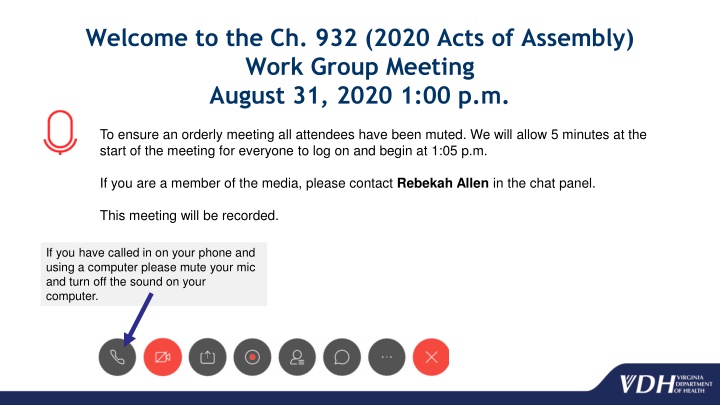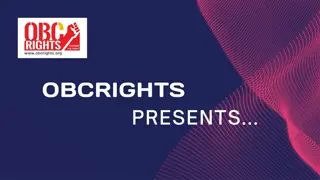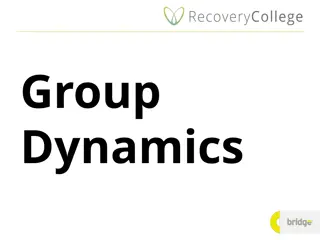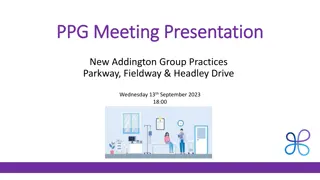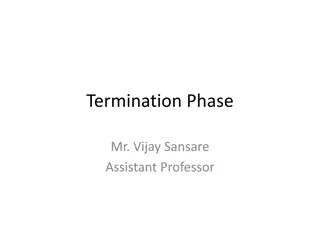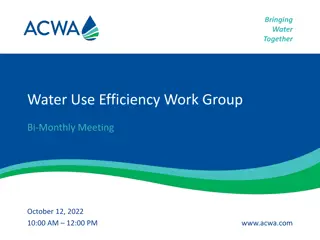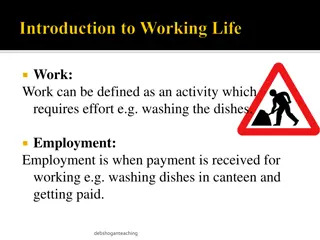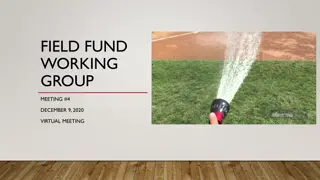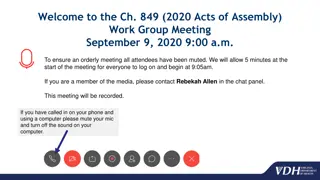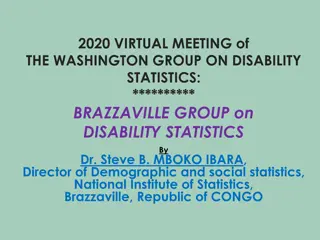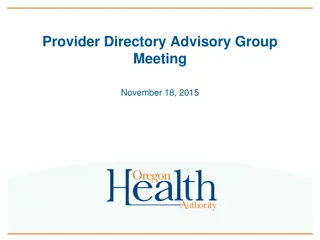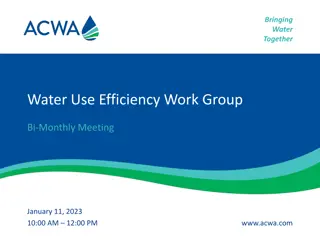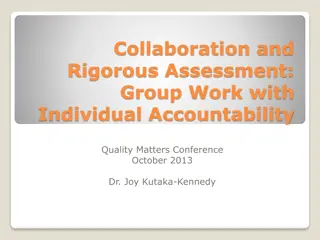Work Group Meeting
This is a summary of the Ch. 932 (2020 Acts of Assembly) Work Group Meeting held on August 31, 2020, at 1:00 p.m. The meeting included roll calls of members from various organizations and agencies. Attendees were muted to ensure an orderly meeting. The meeting started with a call to order and welcome. Members from different sectors like healthcare, social services, and government were present at the meeting. The meeting aimed to discuss relevant topics and initiatives related to their respective fields.
Download Presentation

Please find below an Image/Link to download the presentation.
The content on the website is provided AS IS for your information and personal use only. It may not be sold, licensed, or shared on other websites without obtaining consent from the author.If you encounter any issues during the download, it is possible that the publisher has removed the file from their server.
You are allowed to download the files provided on this website for personal or commercial use, subject to the condition that they are used lawfully. All files are the property of their respective owners.
The content on the website is provided AS IS for your information and personal use only. It may not be sold, licensed, or shared on other websites without obtaining consent from the author.
E N D
Presentation Transcript
Welcome to the Ch. 932 (2020 Acts of Assembly) Work Group Meeting August 31, 2020 1:00 p.m. To ensure an orderly meeting all attendees have been muted. We will allow 5 minutes at the start of the meeting for everyone to log on and begin at 1:05 p.m. If you are a member of the media, please contact Rebekah Allen in the chat panel. This meeting will be recorded. If you have called in on your phone and using a computer please mute your mic and turn off the sound on your computer.
Roll Call Work Group Member Organization or Agency Alaysia Black Hackett Chief Diversity Officer Meaghan Green Chief Workforce Development Advisor Judy Jackson Department for the Blind and Vision Impaired Karen Brimm Department for the Deaf and Hard of Hearing Joani Latimer Department of Aging and Rehabilitative Services Gail Thompson Department of Aging and Rehabilitative Services Jewel Bronaugh Department of Agriculture and Consumer Service Kathryn Paxton Department of Agriculture and Consumer Service Charlette Ridout Board of Nursing, Department of Health Professions Healthcare Workforce Data Center, Department of Health Professions Board of Long-Term Care Administrators, Department of Health Professions Elizabeth Carter Corie Tillman Wolf Kurt Elward Department of Medical Assistance Services Barbara Seymour Department of Medical Assistance Services Randall Stamper Virginia Community College System
Roll Call Work Group Member Organization or Agency Todd Barnes Department of Veterans Services Heather Legere Department of Veterans Services Sam Kukich Dignity for the Aged Bob Kukich Dignity for the Aged Erin Hines Dignity for the Aged Susan Hines Dignity for the Aged Lionel DeCuir Dignity for the Aged Jen A. Kiggans Senate, General Assembly Christina Holloway Beach Health and Wellness Dana Parsons LeadingAge Virginia Alicia Cundiff LeadingAge Virginia Virginia Health Care Association | Virginia Center for Assisted Living Virginia Health Care Association | Virginia Center for Assisted Living April Payne W. Scott Johnson Vivienne McDaniel Virginia Nurses Association
Roll Call Work Group Member Organization or Agency Office of Governmental and Regulatory Affairs, Department of Health Joseph Hilbert Heather Anderson Office of Health Equity, Department of Health Office of Governmental and Regulatory Affairs, Department of Health A. Carole Pratt Rebekah E. Allen Office of Licensure and Certification, Department of Health
Ch. 932 (2020 Acts of Assembly) Work Group - Agenda Public Comment Period Nursing Home Staffing & Supporting the Development of Virginia s Nursing Home Workforce Review of Recommendations Discussed to Date Brenden Rivenbark Office of Governmental & Regulatory Affairs, VDH Ms. Allen Recommendations Discussion Ms. Allen, Dr. Pratt & Work Group Members Discussions of Next Steps Ms. Allen & Dr. Pratt Other Business Ms. Allen & Dr. Pratt
Written Public Comment Written comments were emailed to members on Monday morning Posted on OLC s website at https://www.vdh.virginia.gov/licensure- and-certification/laws-regulations-and-guidelines/current-legislative- work-groups-reports/ under Ch. 932 (2020 Acts of Assembly) in the Meetings section As a reminder, a summary of written comments will be included in the work group s final report Written comments should be sent to Rebekah.Allen@vdh.virginia.gov and Carole.Pratt@vdh.virginia.gov
Public Comment Period There is a two minute time limit for each person to speak. We will be calling from the list generated through registration. After the 2 minute public comment limit is reached we will let you complete the sentence and will mute you and move on to the next attendee. We will call the name of the person on list and also the name of the person is next on the list.
Nursing Home Staffing and Supporting the Development of Virginia s Nursing Home Workforce Brenden Rivenbark Virginia Department of Health August 31, 2020
Overview Workgroup Background Staffing in Virginia and Nationwide State Comparison Data Bridging the Gap in Virginia: Opportunities for Recommendations Discussion Next Steps 10
Background The Chapter 932 work group is tasked with making recommendations to increase the availability of the clinical workforce for Virginia s nursing homes. Virginia s nursing home staffing challenges, as in other states, is multifaceted and as such, will require a braided approach to address. Staffing ratios, often defined in terms of hours per resident day (HPRD) or a staff-to-resident ratio, may serve as a north star for the working group to develop recommendations. 11
Staffing Impact & Context Licensed nurses, certified nursing assistants (CNAs), and other personal care aids are critical to the physical, mental, behavioral, and social well-being of nursing home residents. Numerous studies have found a positive relationship between nursing home quality and staffing, yet many nursing homes have lower than sufficient nursing home staffing levels.12 In addition to the burden low staffing levels have on nursing home residents, the increased workload placed on existing staff increases burnout, exacerbating shortages. 12
Nursing Home Staffing in Virginia In Virginia, licensed nursing homes are required to provide qualified nurses and certified nurse aides on all shifts, seven days per week, in sufficient number to meet the assessed nursing care needs of all residents. 1 Sufficient is not further defined in Virginia s licensure. The Centers for Medicare & Medicaid Services (CMS) require certified nursing homes that provide services to Medicare and/or Medicaid beneficiaries have on staff:2 a full-time director of nursing (DON); a registered nurse (RN) on duty for 8 consecutive hours 7 days a week; and one RN and additional licensed nurse (RN or LPN) for the two additional shifts. 13
Nursing Home Staffing Ratios in Other States While certified nursing facilities in other states are required to adhere to staffing standards as defined by CMS, many states have imposed more strict and defined staffing requirements. State Minimum Nursing and Direct Care Requirements CA3 3.5 HPRD with a minimum of 2.4 HPRD by CNA IL4 3.8 HPRD for residents needing skilled care and 2.5 HPRD for residents needing intermediate care, with at least 25% of HPRD being provided by a licensed nurse and the remainder by personal care providers (i.e. CNAs, therapists, etc.) ME5 On the day shift, one direct-care provider for every 5 residents; On the evening shift, one direct-care provider for every 10 residents; and On the night shift, one direct-care provider for every 15 residents *Direct-care provider refers to RN, LPN, and CNA D.C.6 Minimum daily average of 3.5 HPRD provided by RN, LPN, and/or CNA FL7 A minimum weekly average of certified nursing assistant and licensed nursing staffing combined of 3.6 HPRD, with minimum CNA staffing of 2.5 HPRD, a CNA to resident ratio of 1:20, a minimum licensed nursing staffing of 1.0 HPRD and a licensed nursing to resident ratio of 1:40. 14
State Comparison Data State Reported Ratio10 Number of hospitalizations per 1,000 long- stay resident days10 CNA Hourly Mean Wage9 Total CNA Workforce9 Employment per 1,000 Jobs9* Medicaid Spend per Aged Enrollee11 CA 4.35 HPRD (2.58 w CNA) 1.88 $17.61 100,190 5.764 $10,889 IL 3.43 HPRD (2.01 w CNA) 1.83 $14.31 60,370 10.018 $11,912 ME 4.5 HPRD (3.01 w CNA) 1.27 $14.79 9,020 14.761 $7,143 D.C. 5.1 HPRD (2.8 w CNA) 0.91 $16.98 3,460 4.783 $19,186 FL 4.3 HPRD (2.7 w CNA) 1.93 $13.36 87,840 9.989 $7,281 VA 3.8 HPRD (2.1 w CNA) 1.48 $14.13 41,140 10.606 $13,879 Nat. Avg 3.87 HPRD (2.3 w CNA) 1.7 $14.77 1,419,920 $13,063 15 *Employment per 1000 jobs: the number of jobs (employment) in the given occupation per 1,000 jobs in the given area
Initial Observations While nursing assistants are concentrated in nursing homes, they are paid similarly or less than nursing assistants working in hospitals, assisted living facilities, and home health.9 Many states that have passed mandates for staffing ratios had to do so with a waiver system that allows facilities to request regulatory relief based on regional nursing staffing shortage and other allowed exemptions. Facilities that cannot meet mandates may be forced to turn down admissions. Higher staffing ratios and pay does not necessarily equate to quality. Depending on a state s mandate and a facility's staffing structure, more emphasis may be placed on traditional nursing care to meet mandated ratios rather than personal care.8 Virginia s overall reported ratios match, if not exceed, the ratios mandated in other states, though improvement is needed in CNA HPRD. Higer Medicaid expenditures per enrollee does not guarantee higher wages for CNAs nor improved nursing home quality outcomes. Mandating ratios does not solve the financing, recruitment, and retention infrastructure needed to adequately support nursing homes, staff, and their residents. 16
Opportunities for Recommendations Considerations: Amend regulations (18VAC90-25-80) to require continuing education for recertification. Amend regulations (18VAC90-25-80) to require more than 40 hours of clinical experience for certification. Amend regulations (18VAC90-26-30) to include CNAs in the CNA Training/Education instruction team. 01 Include licensed nurses and CNAs in the development and execution of all recommendations Ensure equity is a focal point in the development and execution of recommendations. Quality of care, patient satisfaction, and staff satisfaction are key Workforce Development and Quality Improvement Develop a plan for career ladders in partnership with the Board of Nursing, Virginia Nurses Association, VHCA, LeadingAge Virginia, VHHA, providers, VDH, etc. Develop an education and outbreak campaign with the Board of Nursing, VNA, VHCA, LeadingAge Virginia, VHHA, providers, VDH, and others to engage high school students in their career planning. 02 Workforce Recruitment and Retention Convene the Board of Nursing, Virginia Nurses Association, VHCA, VAHP, LeadingAge Virginia, VHHA, providers, VDH, and others to develop strategies and a budget to increase funding to nursing homes dedicated to CNA wage increases, workforce development, and retention. 03 Financing Following intentional workforce development initiatives, explore statutory changes for minimum staffing ratios for licensed nursing homes. 04 Statute/Regulation 17
References 1 https://law.lis.virginia.gov/admincode/title12/agency5/chapter371/section210/ 2 https://www.cms.gov/Regulations-and-Guidance/Guidance/Manuals/downloads/som107ap_pp_guidelines_ltcf.pdf 3https://www.cdph.ca.gov/Programs/CHCQ/LCP/Pages/AFL-18-16.aspx 4https://www.ilga.gov/commission/jcar/admincode/077/077003000F12300R.html 5https://www.maine.gov/sos/cec/rules/10/ch110.htm 6https://doh.dc.gov/sites/default/files/dc/sites/doh/publication/attachments/Nurse_%20Staff_%20Guid_22%20DCMR_%2032 11.3_%2008_25_08.pdf 7http://www.leg.state.fl.us/statutes/index.cfm?App_mode=Display_Statute&URL=0400-0499/0400/Sections/0400.23.html 8https://health.wusf.usf.edu/post/nursing-home-staffing-changes-considered#stream/0 9https://www.bls.gov/oes/current/oes311131.htm#nat 10https://www.medicare.gov/nursinghomecompare/profile.html#profTab=4&ID=105335&Distn=7007.8&state=FL&lat=0&lng=0 11https://www.kff.org/medicaid/state-indicator/medicaid-spending-per- enrollee/?currentTimeframe=0&selectedDistributions=aged&selectedRows=%7B%22states%22:%7B%22california%22:%7B%7D,%2 2district-of- columbia%22:%7B%7D,%22florida%22:%7B%7D,%22illinois%22:%7B%7D,%22maine%22:%7B%7D,%22virginia%22:%7B%7D%7D,%22wr apups%22:%7B%22united-states%22:%7B%7D%7D%7D&sortModel=%7B%22colId%22:%22Location%22,%22sort%22:%22asc%22%7D 12https://www.ncbi.nlm.nih.gov/pmc/articles/PMC4833431/ 19
Voting on Recommendations Each stakeholder (e.g., organization or agency) gets one vote per recommendation Each stakeholder to designate one person to vote on its behalf Please send the name and email address of the designated person to Dr. Pratt (carole.pratt@vdh.virginia.gov) and Ms. Allen (rebekah.allen@vdh.virginia.gov) on or before September 8, 2020 Voting options are Support, Oppose, or Abstain For a recommendation be included in the report, a simple majority must vote in favor Voting is public If a stakeholder opposes a recommendation, it may submit written comment explaining its dissenting viewpoint, to be included in the report
Chapter 932 (2020 Acts of Assembly) Be it enacted by the General Assembly of Virginia: 1. 1. That the Department of Health shall convene a work group to review and make recommendations on increasing the availability of the clinical workforce for nursing homes in the Commonwealth. The work group shall include representatives from the Virginia Health Care Association, the Virginia Center for Assisted Living, Dignity for the Aged, the Virginia Nurses Association, LeadingAge Virginia, and other stakeholders as appropriate. The Department shall collaborate with the Department of Health Professions, the Governor's Chief Workforce Development Advisor, and other state agencies as appropriate. The Department shall report all recommendations to the Chairmen of the Senate Committee on Education and Health and the House Committee on Health, Welfare and Institutions on or before November 15, 2020.
Potential Recommendations to Date Permit, but not require, local school boards to offer graduation credit for service learning Statewide offering of optional graduation credit for service learning Implement Fairfax County Public Schools service learning project model statewide (i.e., required for students in grades 6, 8, and 12, with optional diploma seal) Require changes to nursing home regulations to permit volunteerism and service project learning in nursing homes, with appropriate supervision Expand eligibility of Nurse Loan Repayment Program to include CNAs Fund the Nursing Scholarship and Loan Repayment Fund
Potential Recommendations to Date (cont.) Establish education and outreach programs for middle school and high school students to promote career pathways in long term care Funding for Advanced Certification for CNAs upon conclusion of pilot program Increase wages for CNAs proportional to regional living wage standards Increase funding of Medicaid nursing care services Establish financial incentives to support working parents in the areas of childcare and transportation costs Creating a workforce program similar to Virginia Values Veterans (V3) Program for people with disabilities to increases employment opportunities and promotes economic development by training and certifying organizations in disability workforce best practices
Potential Recommendations to Date (cont.) Require changes to nursing home regulations to permit care by non- credentialed individuals in the MMAC program Civilian credentialing/licensing reciprocity so state regulatory bodies recognize civilian equivalency of certain military allied health specialties. Civilian educational credits for statewide standardized recognition of military medical education and awarding of equivalent credit hours Awareness Campaigns for MMAC Program and the healthcare employment opportunities provided by the program
Potential Recommendations to Date (cont.) State income tax credit for CNAs, LPNs, and RNs working at licensed nursing homes and certified nursing facilities State income tax credit for private-sector businesses for hiring individuals from any of ten target groups who have consistently faced significant barriers to employment. State income tax credit for disabled access for for-profit nursing homes Tax relief program for not-for-profit nursing homes that would allow them to offset part of their payroll tax for expenditures aimed at providing access to employees with disabilities
